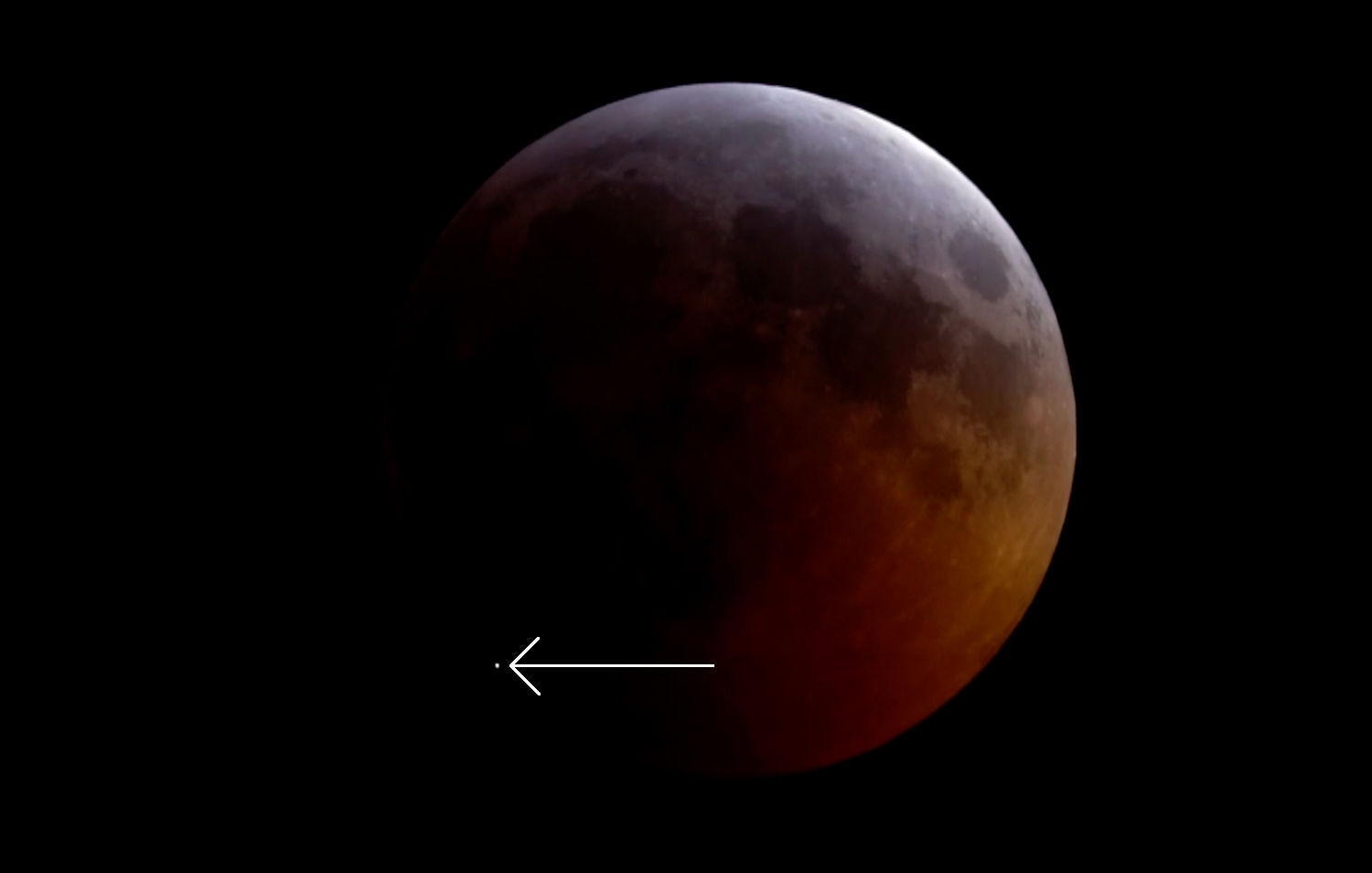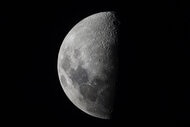Create a free profile to get unlimited access to exclusive videos, sweepstakes, and more!
UPDATE: The lunar eclipse impact was from a beachball-sized rock moving at 61,000 kph!

During the evening January 20/21, 2019, the Moon slipped into the Earth's shadow to create a lovely total lunar eclipse that lasted for several hours, and was witnessed by millions of people.
Fewer people, though, saw what happened at 4:41:38 UTC (11:41:38 p.m. Eastern US time) that evening: A small bit of interplanetary debris slammed into the Moon's surface, creating a decent-sized explosions and a split-second flash of light. Happily, enough people did see it to raise an alarm, and, even better, it was caught by multiple telescopes… including those of the Moon Impacts Detection and Analysis System (MIDAS), a project designed specifically to watch lunar impacts.
Using those telescopes, astronomers have been able determine quite a bit about what caused the impact. Their conclusions: An object between 36 and 66 centimeters across with a mass of about 45 kilograms slammed into the Moon's surface moving at 61,000 kilometers per hour. The energy of impact was equivalent to detonating 1.5 tons of TNT, creating a fireball at a temperature of 5,700 Kelvins that probably carved a crater 10–15 meters across on the Moon.
Cooooooool.
MIDAS uses three observatories in Spain to monitor the Moon for flashes of light indicating impacts. On the night of the eclipse two of those observatories were clouded out, but the third, in Sevilla, had clear views. Multiple telescopes are used at each observatory; some take video, some take still images. One of each caught the impact on the night of the eclipse, and it was using those detections that the scientists were able to make their calculations.
The first thing they found was how bright the impact was. The visible flash lasted a mere 0.28 seconds, but got as bright as a 4th magnitude star from here on Earth (about the faintest you can see from a mildly light-polluted area). Then they translated that into how much energy was released.
I love this part. If you heat up matter, it releases that heat by glowing at different wavelengths — which are what we think of as colors. For historical reasons this is called blackbody radiation, and it has a unique curve when you graph brightness versus color. The video camera hooked up to one of MIDAS's telescopes was taking RGB video, so they broke it down into the component red, green, and blue frames, measured their brightnesses, and then fit a blackbody curve to it. The best fit they got was for a temperature of 5,700 Kelvin (5,430°C or 9,800°F) — about the same temperature as the surface of the Sun.
The next bit was to find out how much energy was released by the impact. When a meteoroid moving at high velocity slams into the ground, some of the energy of motion — called kinetic energy — is converted into a visible flash, but most goes into a shock wave that carves out the crater and ejects material all around it. It's not well known how much energy goes into light, but in general it's about 0.2 – 0.3%… in other words, very little. Yet it was enough to make the flash visible on Earth to the naked eye!
Using that conversion they could scale up the flash seen to how much energy total there was on impact: about 6.6 billion Joules, equivalent to blowing up a ton and a half of TNT.
How big is that? As it happens, I have some handy video showing an explosion with about twice that much TNT:
[My speech to the mannequin was ad libbed by the way.] Anyway, the crater we made in that show was about 18 or so meters across. The size of the crater doesn't scale linearly with explosive yield (in other words, doubling the energy doesn't double the crater diameter), so 10–15 meters across for the lunar crater size sounds about right to me.
That's big enough to be seen by the Lunar Reconnaissance Orbiter, a NASA spacecraft that's been circling the Moon since 2009. It'll look pretty small, but new impacts can be obvious because they excavate brighter material under the surface, and create fan-like rays that can extend for dozens of meters in the case of smaller impacts like this.
Since the impact energy depends on the mass of the object and its speed, the astronomers found the best fit was for an object with a mass of 45 kilos moving at 17 kilometers per second. Knowing the mass gives you the size, but that depends on the density. The impactor was most likely made of asteroidal rocky material, which would give it a size of about 36 centimeters. If it were more cometary, making it less dense, it would've been about twice that big at 66 cm.
So, a size somewhere between a volleyball and a beachball. Imagine! Something that small having such a huge impact! Amazing.
Incidentally, this was unlikely to be associated with a meteor shower. We know the directions those come in from, and the part of the Moon where this one hit was in the wrong place to get hit from any known showers. Therefore this was likely a random rock, what astronomers call a "sporadic" (the astronomers calculate the chance of it being sporadic as 99%). These are generally from asteroids, so it's likely it was rocky and therefore on the small end of the size scale.
All this is cool, but more than just idle curiosity. It's hard to measure the background amount of small stuff impacting the Earth, because we're on the planet and it's hard to monitor the entire sky around us. But we can look at vast areas of the Moon all at the same time, giving us a pretty concrete baseline for small impacts, which we can scale up for the Earth (because we're physically a bigger target, and also Earth's gravity pulls in more material than the Moon's weaker gravity).
And besides just the scientific knowledge we accrue, this helps us understand the threat of impacts both from small rocks like this one (which can't hurt us here on Earth because they burn up in our air, but can destroy satellites) and larger ones. Thank goodness larger impacts are more rare! But they do happen, so the more we understand how this all works, the better.














